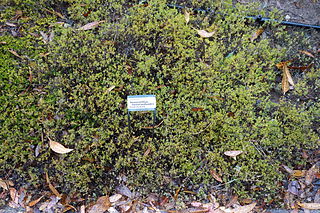
Homoranthus is a genus of about thirty species of plants in the myrtle family Myrtaceae and all are endemic to Australia. Plants in this genus share similarities with those in both Darwinia and Verticordia. They are shrubs with their leaves arranged in opposite pairs and with flowers appearing either singly or in small groups, usually in upper leaf axils. They are found in Queensland, New South Wales and South Australia. The genus was first described in 1836. None of the species is common nor are they well-known in horticulture.

Homoranthus darwinioides, commonly known as fairy bells, is a species of flowering plant in the family, Myrtaceae. It is a small, spreading shrub with pendulous yellow and pink flowers, grey-green leaves and is endemic to New South Wales.

Homoranthus papillatus, commonly known as mouse bush, is a plant in the myrtle family Myrtaceae and is endemic to a small area in southern Queensland. It is a compact shrub with curved, linear leaves and pale yellow flowers arranged in upper leaf axils.

Homoranthus homoranthoides is a plant in the myrtle family Myrtaceae and is endemic to South Australia.

Darwinia biflora is a plant in the myrtle family Myrtaceae and is endemic to New South Wales. It is an erect, often straggly shrub with flattened, glabrous leaves, and flowers which are arranged in pairs. The flowers are greenish in colour but each is surrounded by two purple-red bracteoles and have a long yellow-green style projecting out of the flower tube. The species only occurs in the Sydney region in a few places where shale-capped ridges intergrade with Hawkesbury sandstone.

Homoranthus biflorus is a plant in the myrtle family Myrtaceae and is endemic to a small area in northern New South Wales. It is an erect shrub with cylinder-shaped leaves and small groups of usually yellow flowers.

Homoranthus virgatus commonly known as twiggy homoranthus, is a species of flowering plant in the family Myrtaceae and is found growing in coastal areas of northern New South Wales and in Queensland. It is an upright shrub with wand-like branches, white to pink flowers in small clusters at the end of branches.
Homoranthus brevistylis is a plant in the myrtle family Myrtaceae and is endemic to a small area in Queensland. It is an upright shrub with pointed, linear leaves and with groups of up to four pale yellow flowers in leaf axils. It is only known from the Blackdown Tableland National Park.

Homoranthus cernuus is a plant in the myrtle family Myrtaceae and is endemic to a small area in the Wollemi National Park. It is a slender shrub with smooth, linear shaped leaves and pairs of pendulous cream-coloured flowers with a pinkish base.

Homoranthus clarksonii is a plant in the family Myrtaceae and is endemic to a small area in Queensland. It is an upright shrub with pointed, linear leaves and pairs of creamy pink to pale yellow flowers which turn pink as they age. It is only known from small populations on Mount Mulligan.

Homoranthus coracinus is a plant in the myrtle family Myrtaceae and is endemic to a small area in Queensland. It is a low, spreading shrub with pointed, narrow egg-shaped leaves and groups of up to six flowers with black petals. It is only known from a single population in the Ka Ka Mundi part of the Carnarvon National Park.
Homoranthus cummingii is a plant in the myrtle family Myrtaceae and is endemic to a small area in Queensland. It is an upright shrub with pointed, linear leaves arranged in alternating opposite pairs so they form four rows along the branchlets. The flowers hang downwards in pairs and are creamy white to pale yellow, turning red as they age. It is only known from Mount Zero north-west of Townsville.

Homoranthus decasetus is a plant in the myrtle family Myrtaceae and is endemic to a small area in central Queensland. It has small, thin leaves and flowers that fade to purple as they age.

Homoranthus decumbens is a plant in the myrtle family Myrtaceae and is endemic to a small area in Queensland. It is a low, spreading shrub with cylindrical leaves arranged in alternating opposite pairs. The flowers are yellowish green and arranged singly in upper leaf axils.

Homoranthus montanus is a plant in the myrtle family Myrtaceae and is endemic to a small area in southern Queensland. It has narrow leaves and up to one to six small tubular, cream-coloured flowers arranged in leaf axils near the ends of the branchlets. As the flowers age, they turn red.

Homoranthus prolixus is a plant in the myrtle family Myrtaceae and is endemic to northern New South Wales. It is a spreading shrub with linear to lance-shaped leaves and groups of up to six yellow to red flowers in the upper leaf axils.

Homoranthus thomasii is a species of flowering plant in the family Myrtaceae and is endemic to Queensland. It is a small shrub with spoon-shaped, greyish green leaves and small, pendulous, pink flowers in the upper leaf axils.
Homoranthus tricolor, is a plant in the myrtle family Myrtaceae and is endemic to a small area in south-east Queensland. It is an upright shrub with linear to lance-shaped leaves and green, red and black flowers arranged singly or in pairs in upper leaf axils. It is only known from a single population near Mundubbera.

Homoranthus tropicus is a plant in the myrtle family Myrtaceae and is endemic to tropical north Queensland. It is a shrub with curved, club-shaped leaves and white flowers in a corymbose-like arrangement on the ends of branchlets.

Homoranthus zeteticorum is a flowering plant in the family Myrtaceae and is endemic to a small area in central Queensland. It is a tall shrub with axehead-shaped leaves and pendulous flowers with darker styles. It is only known from the Salvator Rosa section of Carnarvon National Park where it grows on Homoranthus Hill.



















